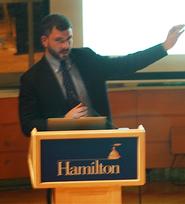
Sean Safford describes the difference between Allentown, Pennsylvania, and Youngstown, Ohio, as the difference between a “mediocre Billy Joel song” and a “really awesome Bruce Springsteen song.” He observes that the significant difference could be found in the civic structure of the two cities.
Safford, an assistant professor of management at the University of Pennsylvania’s Wharton School, came to Hamilton on Nov. 10 to talk about the reasons these two Rust Belt cities are different. His lecture titled “Why the Garden Club Couldn’t Save Youngstown: Lessons for Regional Resilience,” was part of the Levitt Center's Sustainability series.
Safford argued that the main reason some cities survived the economic “competitive crisis” of the late 1970s and early 1980s while others didn’t is connectedness. He evaluated cities that were broadly similar in the 1950s, sharing a comparable manufacturing base, family income, and population.
Through network data, he showed that cities with a few important social institutions, such as Allentown, do well. In contrast, cities like Youngstown, which has many equally popular civic groups, do not. He argued that Allentown thrived because civic organizations were not directly tied to economic ones; when Bethlehem Steel, Allentown’s biggest employer, collapsed, there were civic institutions to pick up the slack. In contrast, Youngstown’s two big steel companies, Republic Steel and Youngstown Sheet & Tube, were tied into all the social groups (such as the lecture’s eponymous Youngstown Garden Club). When the steel companies in Youngstown failed, there was a total collapse of the civic infrastructure as well.
Civic reinvestment is the primary effect of this connectedness. Investment is the main source of the current economic success in Allentown and troubles in Youngstown. Safford quoted the president of Lehigh University in Bethlehem, who said that the university was “liberated” by the fall of Bethlehem Steel. The school was able to create its own identity and establish its independence from the company, and was consequently able to establish a significant and positive footprint in the community. It sought to create an environment to bring community leaders together after the previous community hub, Bethlehem Steel, departed.
In contrast, Safford says that Youngstown “lacks the mechanism to bring [these] leaders together,” and as a result it is suffering economically. Many companies based in Youngstown actively try to avoid the city. One Youngstown technology startup, hurt by the dot-com bubble bursting in the early 2000s, outsourced its entire operation to Mexico. In contrast, an Allentown-based startup responded by “insourcing” and moving many worldwide operations back to Allentown.
After describing the state of two Rust Belt towns, Safford closed the lecture by asking “what can we do about it?” He answered his question by comparing two more Rust Belt towns, Rochester and Akron, through a “forum” vs. “fountain” framework. He described both in the context of the large universities that operate in each town. Forums were cited as places where businesses both small and large could interact –t his was the model used by the University of Rochester. The University of Akron applied a “fountain” model, attempting to be a wellspring of talent for the Akron business community.
To evaluate the level of community cooperation, Safford looked at how many patents were registered jointly, that is, between companies. Interconnection could be inferred when patents were registered by a university and a company together, or when a large and small company collaborated. The patent data showed that the Rochester model led to much more collaboration than the Akron model; in Rochester, talent was able to “come together.” In Akron, once talent left the university, it never branched out, so companies stayed apart. Safford argued that the interconnectedness in Rochester will enable it to survive uncertain economic times, while the independence of companies in Akron will lead them to suffer.
Rust Belt revival is a natural topic for Safford, who was born in Syracuse and raised in Buffalo. He noted early in the lecture that he was interested in the topic substantively; as he said, there were “big practical questions of what to do with mature industrial cities.” In addition, his results contrast with some prominent research in the field. The most notable, Robert Putnam’s Bowling Alone, suggests that connectivity alone is enough for a community to thrive. Safford’s work suggests that community is not enough; as he said, “in Buffalo, we bowl, but Buffalo isn’t doing well.” Regional resilience, Safford argued, must come from a specific type of interconnectedness--one that causes the important community figures to come together for mutual benefit.
